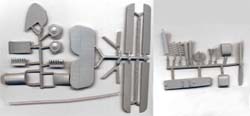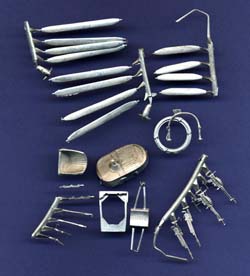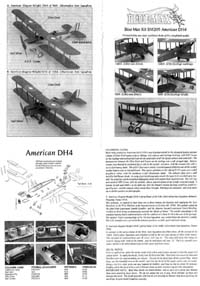BLUE MAX 1/48 AMERICAN DH4
By Karen Rychlewski
 |
Introduction
The D.H.4 was Geoffrey deHavilland's first truly great design. Of standard wood and cloth construction, this handsome two-seater first flew in August, 1916. It served in the RAF and the RNAS throughout the war as a fighter-reconnaissance and bomber aircraft all along the Western Front and in the Middle East. A variety of engines was fitted to the D.H.4 which caused difficulty in maintenance and parts replacement. When the United States entered the war in April, 1917, a military commission began evaluating aircraft for U.S. production; the D.H.4 garnered the top recommendation. But typical bureaucratic confusion resulted in orders being placed for well over 7000 D.H.9s and only 1000 DH-4s from the Fisher Body Corporation, the Dayton-Wright Airplane Company, and Standard Aircraft Corporation, with the DH-4s being intended only as trainers. By the end of January, 1918, it was decided that the D.H.9 design was not sufficiently proven, and in mid-February, all the D.H.9 contracts were altered to require DH-4s instead. The first American-built DH-4 was delivered by the Dayton-Wright company in February, 1918, and by the end of that year over 3000 had been built and over 400 had flown with U.S. squadrons in France.
There were a number of differences between the British D.H.4 and its American cousin, the most significant of which were the use of a V-12 Liberty engine in all the U.S.-built machines, a slimmer rear fuselage, and the shape of the rudder. The American DH-4s flew for about three months at the end of the war and distinguished themselves in combat and bombing raids though they were flown by inexperienced crews. Nevertheless, four of the six Medals of Honor awarded to American aviators were won by DH-4 crews. Also, the first airplane to sport the US Marine Corps eagle and anchor insignia in combat was a DH-4.
THE KIT
This is a kit that has been long and eagerly awaited; its predecessors in 1/48, the Aurora and AMC kits (for British D.H.4s), were poor at best, with a host of problems beginning with gross dimensional inaccuracies and ending with 'fabric' texture to the approximate scale of 1:1. The announcement of the Blue Max kit about six months ago set many modelers drooling over the possibility of finally being able to build this historically significant aircraft; therefore it seemed to this reviewer that an examination of the accuracy of the kit parts was in order. Unfortunately (and strangely), there is far less information available about the US DH-4 than the British-built ones – and what IS available is somewhat contradictory.
But first, what's in the box?
 As the photos show, there are three sprues of typical Blue Max heavy runners holding most of the plastic parts. There is some flash on virtually every piece, but it won't be too difficult to clean off – except for the tailplane and rudder, the sprue attachment points are at spots that don't interfere with the cast details. The parts are not numbered, but this shouldn't be a problem as they are easy to identify.
As the photos show, there are three sprues of typical Blue Max heavy runners holding most of the plastic parts. There is some flash on virtually every piece, but it won't be too difficult to clean off – except for the tailplane and rudder, the sprue attachment points are at spots that don't interfere with the cast details. The parts are not numbered, but this shouldn't be a problem as they are easy to identify.
 The four wing halves and the two fuselage halves are loose and very well done with a wealth of detailing inside and out – the rib tapes on the wings, tailplane, and rudder are especially nice and should look great under a coat of paint. These wings don't share the notorious 'ripple' characteristic of many Blue Max kits, but are straight and flat where they're supposed to be; the tailplane, however, is a bit clunky along its leading edge. Locating holes are provided for all the struts and the lower wings, but not the upper wing which has three parts and could be very tricky to assemble. Flying surfaces are all a bit heavy, with thick trailing edges that could use a sanding session – but be careful not to sand off the rib tapes.
The four wing halves and the two fuselage halves are loose and very well done with a wealth of detailing inside and out – the rib tapes on the wings, tailplane, and rudder are especially nice and should look great under a coat of paint. These wings don't share the notorious 'ripple' characteristic of many Blue Max kits, but are straight and flat where they're supposed to be; the tailplane, however, is a bit clunky along its leading edge. Locating holes are provided for all the struts and the lower wings, but not the upper wing which has three parts and could be very tricky to assemble. Flying surfaces are all a bit heavy, with thick trailing edges that could use a sanding session – but be careful not to sand off the rib tapes.
 The upper and lower engine cowlings have crisp louvers and the other smaller parts show good definition of engraved and applied detail. My first look in the box sent me searching for two more engine halves to complete the V-12, but I eventually decided that the two halves included would have to suffice. They will have to be installed contrary to the exploded view instructions which seem to show a 6 cylinder in-line engine (!) – in order to meet the exhaust pipes, each half will have to lean at an angle against the inside of the fuselage/cowling. The engine halves are rudimentary, but they are barely visible from the outside and should look OK. The prop looked suspiciously thick to me, but it is apparently the correct shape – if perhaps a tad too long.
The upper and lower engine cowlings have crisp louvers and the other smaller parts show good definition of engraved and applied detail. My first look in the box sent me searching for two more engine halves to complete the V-12, but I eventually decided that the two halves included would have to suffice. They will have to be installed contrary to the exploded view instructions which seem to show a 6 cylinder in-line engine (!) – in order to meet the exhaust pipes, each half will have to lean at an angle against the inside of the fuselage/cowling. The engine halves are rudimentary, but they are barely visible from the outside and should look OK. The prop looked suspiciously thick to me, but it is apparently the correct shape – if perhaps a tad too long.
 Along with the 34 grey plastic parts, there's a bag of 32 cast pewter pieces which looked like silver pretzels. Not to fear: the pewter is very soft and easily bendable to shape (maybe again and again...) and the pieces probably won't be too tough to clean up. The metal parts have clean edges and good detail, especially the radiator and the two Marlin machine guns. There is a 6 inch length of plastic strut stock to make the tailplane struts.
Along with the 34 grey plastic parts, there's a bag of 32 cast pewter pieces which looked like silver pretzels. Not to fear: the pewter is very soft and easily bendable to shape (maybe again and again...) and the pieces probably won't be too tough to clean up. The metal parts have clean edges and good detail, especially the radiator and the two Marlin machine guns. There is a 6 inch length of plastic strut stock to make the tailplane struts.
The small decal sheet provides national markings for wings and rudder and a choice of two squadron markings: the 'Dutch cleanser lady' of the 50th Observation Aero Squadron and the 'flying skull' of the 168th OAS. Serial numbers for the fuselage sides are included. The printing is excellent and the red and blue colors look accurate enough; but the 'flying skull' is not quite the right shape (and it shouldn't be smiling!) and is missing the lines detailing the wings and skull. Both insignia are too small and on the instruction sheet are shown too far forward (1). The 'Dutch cleanser lady' markings ostensibly represent a plane used to drop supplies to the 'Lost Battalion' in mid-October, 1918; there is some question as to whether the insignia would actually have been on the plane at that time so some research would be in order if one chooses to use this marking.
 Lastly, the instruction sheet is the usual woefully inadequate single page 'booklet' with only an exploded view drawing, about a dozen photos of the model in progress and finished, and color notes. No GA drawings, no reference list, no rigging diagram – I mean, really! in this day and age! I think most modelers would be happy to plop down an additional dollar if it bought more and better documentation. On the other hand, better documentation would expose many of the kit's flaws.
Lastly, the instruction sheet is the usual woefully inadequate single page 'booklet' with only an exploded view drawing, about a dozen photos of the model in progress and finished, and color notes. No GA drawings, no reference list, no rigging diagram – I mean, really! in this day and age! I think most modelers would be happy to plop down an additional dollar if it bought more and better documentation. On the other hand, better documentation would expose many of the kit's flaws.
Which brings us to the second part of this review: the burning question – can this kit be built OOB into a reasonable American DH-4? My answer would be a qualified 'maybe' – it depends on your definition of reasonable. If a biplane with four ailerons and exposed control cables can reasonably be built without control horns on those ailerons (not to mention the tail surfaces) – if a USAS aircraft of 1918 can be built without the prominent tricolor chevrons on the upper and lower wing surfaces (not to mention the large numbers on same) (2) – if the missing 'riblets' on the upper wing surfaces don't bother you (2) – if a US DH-4 lacking an observer's windscreen, pilot's seatbelts, teardrop fairings for the undercarriage suspension, and the rear guide light behind the observer's cockpit is to your liking (3) – well then, bunkie, build away! It'll look more like a US DH-4 than anything else, I suppose, but it's not exactly what I was waiting for.
 Overall, the dimensional accuracy is pretty close to published Dayton-Wright factory drawings (4) and the plans for the restored Smithsonian survivor (3). However, after comparing a multitude of drawings and references, the overall length of the kit fuselage turns out to be about 7 or 8 scale inches too short – not much, but noticeable, except that the rudder is ALSO too short in span and visually compensates for it. Ahhh, but the tailplane is NOT shorter, so it's going to look too big (3). Whew! What to do, what to do? The problem seems to be that the rear of the fuselage, from roughly the area of the gas tank to the trailing edge of the rudder, is compressed and everything is pushed forward a bit – and there's no easy fix short of major surgery at the midpoint of the fuselage length. I cannot help but wonder what plans were used by Blue Max to master this kit – I could not find any that matched the kit exactly.
Overall, the dimensional accuracy is pretty close to published Dayton-Wright factory drawings (4) and the plans for the restored Smithsonian survivor (3). However, after comparing a multitude of drawings and references, the overall length of the kit fuselage turns out to be about 7 or 8 scale inches too short – not much, but noticeable, except that the rudder is ALSO too short in span and visually compensates for it. Ahhh, but the tailplane is NOT shorter, so it's going to look too big (3). Whew! What to do, what to do? The problem seems to be that the rear of the fuselage, from roughly the area of the gas tank to the trailing edge of the rudder, is compressed and everything is pushed forward a bit – and there's no easy fix short of major surgery at the midpoint of the fuselage length. I cannot help but wonder what plans were used by Blue Max to master this kit – I could not find any that matched the kit exactly.
There are a few other flaws to mention: the observer's seat is incorrect – every reference shows a seat resembling an old-time piano stool, the kit provides a seat suspended from the top decking; photos clearly show the upper wing radiator header tank to have a wedge-shaped bulge underneath the wing, this is replaced by a narrow rectangular shape on the kit part; the indentation on the port side of the forward fuselage should be an opening with a pipe in it (air intake?); and the wingtips and the corners of the cutouts near the fuselage could be a little more rounded. The lack of a full engine is also disappointing since photos show that many US DH-4s were flown with the top cowling removed and the engine exposed; it would be cool to build it with that big bruiser of a V-12 out in the open. For those so inclined, Aeroclub comes to the rescue with an aftermarket Liberty engine.
Rigging the naked model will be a chore, since research will have to precede any measuring of thread, wire, stretched sprue or whatever. This plane had dual controls and ALL the control cables run on the exterior of the airframe; some unusually-placed double wires also complicate matters. I would recommend Reference #3 as the best source for rigging information, as well as other general information. Don't bother looking for the American DH-4 Windsock Datafile – it's not due until September, 2003.
CONCLUSION
I have mixed feelings about the kit. For a strictly OOB modeler, this kit isn't going to make it; but for those modelers who don't mind adding some simple parts (control horns, seat belts, etc.), it could be a real beauty. Only the most obsessive modeler is going to take the time and effort to correct the fuselage length. Blue Max has provided a boxful of very well cast parts that CAN be made into a reasonably accurate US DH-4, but it's going to take a bit of work. While the kit is several leaps and a bound beyond what has been offered in 1/48 in earlier years, it's not the 'perfect kit'. But then, what kit is?
REFERENCES
-
America's First Eagles, The Official History of the U.S. Air Service, A.E.F, Lt. Lucien Thayer, Bender Publishing & Champlin Fighter Museum Press, 1983
-
De Havilland Aircraft of World War I, Volume 1: D.H.1-D.H.4, Colin Owers, Flying Machine Press, 2001
-
de Havilland DH-4, From Flaming Coffin to Living Legend, Walter Boyne, Smithsonian Institution Press, 1984
-
W.W.I Aero, No. 114, April 1987, page 8
